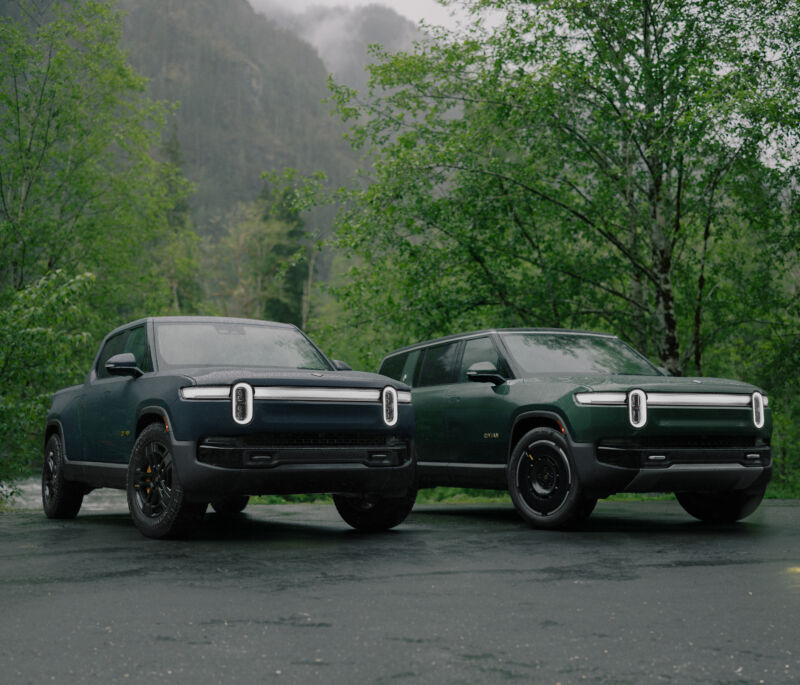
Rivian
In rainy Seattle this week, Rivian unveiled what it’s calling the “Second Generation” of its R1 line with a suite of mostly under-the-hood software and hardware updates that increase range, power, and efficiency while simultaneously lowering the cost of production for the company. While it’s common for automotive manufacturers to do some light refreshes after about four model years, Rivian has almost completely retooled the underpinnings of its popular R1S SUV and R1T pickup just two years after the vehicles made their debut.
“Overdelivering on the product is one of our core values,” Wassym Bensaid, the chief software officer at Rivian, told a select group of journalists at the event on Monday night, “and customer feedback has been one of the key inspirations for us.”
For these updates, Rivian changed more than half the hardware components in the R1 platform, retooled its drive units to offer new tri- and quad-motor options (with more horsepower), updated the suspension tuning, deleted 1.6 miles (2.6 km) of wiring, reduced the number of ECUs, increased the number of cameras and sensors around the vehicle, changed the battery packs, and added some visual options that better aligned with customizations that owners were making to their vehicles, among other things. Rivian is also leaning harder into AI and ML tools with the aim of bringing limited hands-free driver-assistance systems to their owners toward the end of the year.
-
Usually, an automaker waits four years before it refreshes a product, but Rivian decided to move early.
Rivian -
The R1 interior can feel quite serene.
Rivian -
Perhaps you’d prefer something more colorful?
Rivian -
An exploded view of a drive unit with a pair of motors.
Rivian -
There are two capacities of lithium-ion battery, and an optional lithium iron phosphate pack with 275 miles of range is on the way.
-
Rivian’s R1 still looks friendly amid a sea of scary-looking SUVs and trucks.
Rivian
While many of these changes have simplified manufacturing for Rivian, which as of Q1 of this year lost a whopping $38,000 on every vehicle it sold, the company has continued to close the gap with the likes of BMW and Mercedes in terms of ride, handling, comfort, and efficiency.
On the road in the new R1
We drove a new second-gen dual-motor 665 hp (496 kW), 829 lb-ft (1,124 Nm) R1S Performance, which gets up to 410 miles (660 km) of range with the new Max Pack battery, out to DirtFish Rally School in Snoqualmie in typically rainy Seattle weather. On the road, the new platform, with its revised suspension and shocks, felt much more comfortable than it did in our first experience with an R1S in New York in 2022.
The vehicle offers modes that allow you to tackle pretty much any kind of driving that life can throw at you, including Sport, All Purpose (there’s no longer a “Conserve” mode), Snow, All-Terrain, and Soft Sand, alongside customizable suspension, ride feel and height, and regen settings. The R1S feels far more comfortable from all seating positions, including the back and third-row seats. There’s less floaty, car-sick-inducing modulation over bumps in All-Purpose, and Sport tightens things down nicely when you want to have a bit more road feel.
One of the big improvements on the road comes from the new “Autonomy Compute Module” and its suite of high-resolution 4K HDR cameras, radars, and sensors that have been upgraded on the R1 platform. The new R1 gets 11 cameras (one more than the first gen), with eight times greater resolution, five radar modules, and a new proprietary AI and ML integrated system that learns from anonymized driver data and information taken from the world around the vehicles to “see” 360-degrees around the vehicle, even in inclement weather.
While the R1S has had cruise control since its launch, the new “Autonomy” platform allows for smart lane-changing—something Rivian calls “Lane Change on Command” when using the new “Enhanced Highway Assist” (a partially automated driver assist), and centers the vehicle in marked lanes. We tried both features on the highways around Seattle, and the system handled very rainy and wet weather without hesitation, but it did ping-pong between the lane markers, and when that smart lane change system bailed out at the last minute, the move was abrupt and not confidence-inspiring, since there was no apparent reason for the system to fail. These features are not nearly as good as the latest from BMW and Mercedes, both of which continue to offer some of the most usable driver-assist systems on the market.
With the new R1 software stack, Rivian is also promising some limited hands-free highway driver-assistance features to come at the end of the year. While we didn’t get to try the feature in the short drive to DirtFish, Rivian says eye-tracking cameras in the rearview mirror will ensure that drivers have ample warning to take over when the system is engaged and needs human input.




















+ There are no comments
Add yours